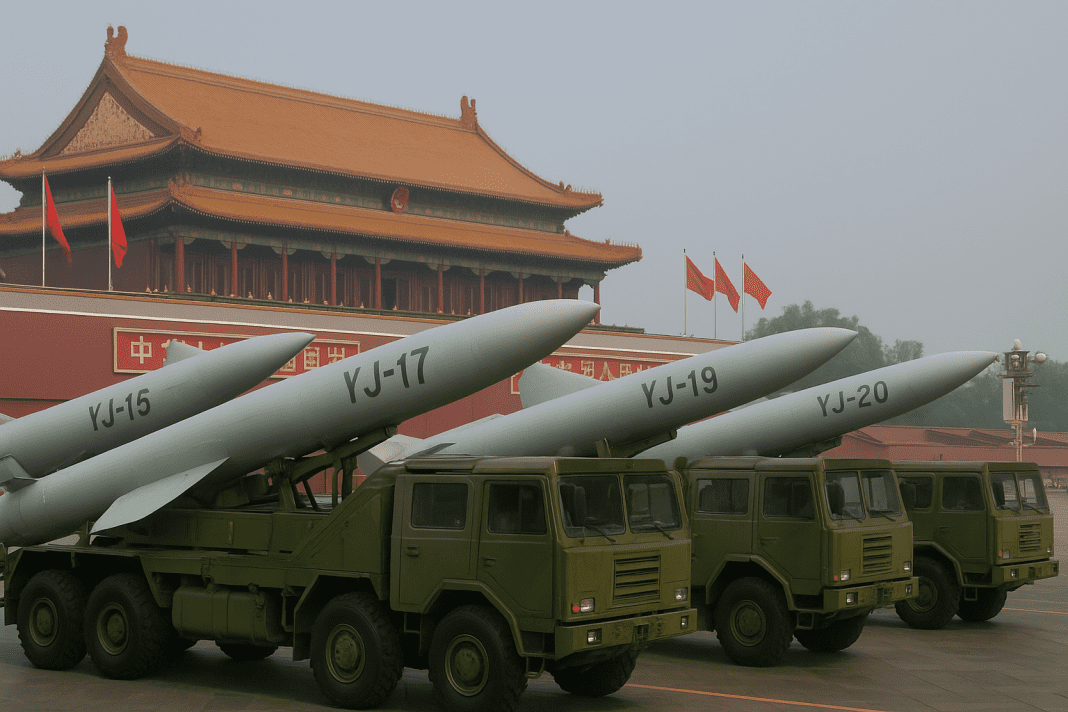China plans to showcase four new advanced missiles that experts say can strike and sink powerful U.S. warships. Observers spotted these missiles during rehearsals for a grand military parade in Beijing’s Tiananmen Square on September 3. China is organizing the parade to mark the 80th anniversary of its victory in World War II.
China unveils new missile arsenal
The missiles are named YJ-15, YJ-17, YJ-19, and YJ-20. Each of them has been developed as part of China’s effort to strengthen its military and modernize its weapons systems. Military analysts explain that these missiles could be used in two different roles. They can target large enemy ships at sea, and they also have the ability to strike land-based targets with precision.
The focus has been particularly strong on the YJ-17 and YJ-19 models. These two are described as hypersonic, meaning they can travel at several times the speed of sound. They are also highly maneuverable, making them difficult to track and even harder to stop once launched. Such features make these missiles dangerous weapons against any naval force operating in the region.
Chinese drone subs set to make first public appearance in Beijing parade
Growing missiles pressure in the Western Pacific
The introduction of these missiles comes at a time of rising tension in the Western Pacific. This area has long been seen as a hotspot where several countries maintain heavy military presence. The waters are important because they are major routes for global trade, energy transport, and naval operations.
For years, the U.S. Navy has maintained dominance in the region by deploying powerful aircraft carriers, destroyers, and submarines. These vessels are symbols of U.S. military strength. However, with China’s new missile capabilities, questions are being raised about the safety of these warships if a conflict were ever to break out.
US Intensifies Crackdown on Chinese Suppliers of Illicit Dual-Use Goods to Houthis
The YJ-17 and YJ-19 hypersonic missiles are particularly concerning because of their speed and agility. Traditional defense systems that rely on radars and missile interceptors could struggle to react quickly enough to neutralize them. Even the YJ-15 and YJ-20, while not described as hypersonic, are advanced enough to pose threats to large ships or land-based command centers.
The timing of the missile reveal has drawn attention because it coincides with significant international developments. While China focuses on strengthening its military power, global discussions are being directed elsewhere, particularly towards the war in Eastern Europe.
Missiles displayed as symbols of power
China’s military parade is not just a national celebration but also a signal to the world about its growing strength. By showcasing the YJ-15, YJ-17, YJ-19, and YJ-20 missiles, China is making clear that it is investing heavily in weapons that can directly challenge the world’s most powerful navy.
The missiles were spotted during the practice sessions for the parade, carried on large vehicles that are designed for road mobility. This makes them easier to transport and deploy quickly across different regions. Analysts point out that road-mobile missile systems are harder to detect and can be repositioned to increase their chances of survival during a conflict.
These weapons add to an already expanding Chinese arsenal that includes aircraft, submarines, and other missile systems. Together, they represent China’s rapid progress in military modernization. Each new development reduces the gap between China’s armed forces and those of the United States.
💣 Poseidon-style torpedoes, laser tanks and mystery missiles storm Beijing streets
The YJ-17 and YJ-19’s hypersonic nature highlights just how far missile technology has advanced. Traveling faster than five times the speed of sound, hypersonic missiles give very little warning to defenders. Their ability to maneuver at such high speeds makes it extremely difficult for anti-missile systems to predict their path or shoot them down.
By presenting these missiles at a highly symbolic parade, China is linking its military modernization with national pride and historical memory. The choice of the 80th anniversary of World War II victory underlines the message that China sees its defense advancements as part of its long struggle for security and strength.

